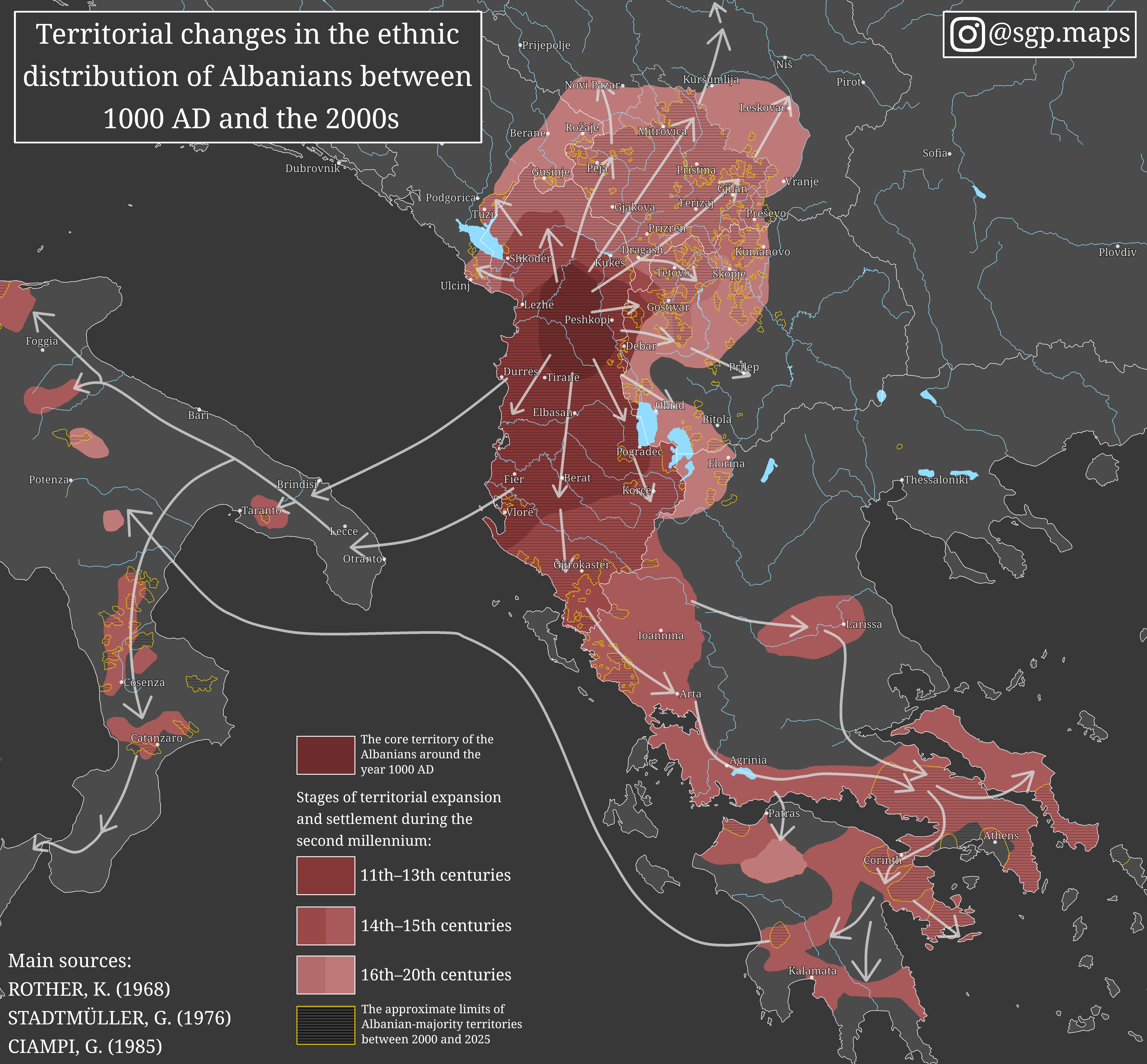Ethnic Distribution Changes of Albanians Map


Marcus Rodriguez
Historical Geography Expert
Marcus Rodriguez specializes in historical cartography and geographic data analysis. With a background in both history and geography, he brings unique...
Geographic Analysis
What This Map Shows
The map titled "Territorial changes in the ethnic distribution of Albanians between 1000 AD and the 2000s" provides an intricate visualization of how the population of ethnic Albanians has shifted over a millennium. By tracking the geographic spread and concentration of Albanians, this map highlights significant historical events, migrations, and sociopolitical changes that have shaped the ethnic landscape of the Balkans. From the medieval period to the modern era, the changes depicted are not just mere statistics; they represent the rich tapestry of cultural identity, conflict, and resilience of the Albanian people.
Deep Dive into Ethnic Distribution
The ethnic distribution of Albanians is a story intertwined with the history of the Balkans, a region known for its complex mosaic of ethnic groups. In 1000 AD, the Albanians were primarily concentrated in the mountainous regions of what is today Albania and Kosovo. However, the expansion of the Ottoman Empire in the 14th and 15th centuries dramatically altered their demographics. During this period, many Albanians migrated to urban centers and surrounding regions, including parts of Macedonia, Montenegro, and Serbia, leading to a more dispersed population.
Interestingly, the 19th century was pivotal for the Albanian national identity, especially during the period of the Albanian Renaissance. This movement encouraged Albanians to reclaim their cultural heritage and promoted the idea of a unified Albanian state. By the late 1800s and early 1900s, many Albanians began to return to their ancestral lands, particularly following the 1912 Declaration of Independence. This led to a resurgence in the population in key areas such as Kosovo and parts of northern Albania.
As the 20th century progressed, the borders established post-World War I and World War II further complicated the ethnic distribution. The map reflects these changes, showing how the ethnic Albanian population fluctuated due to political borders, conflicts, and population exchanges. After the Kosovo War in the late 1990s, many ethnic Albanians sought refuge in neighboring countries or migrated to the West, contributing to a significant diaspora.
Throughout all these shifts, one constant has been the resilience of the Albanian identity. Despite the challenges posed by external forces, including the Yugoslav Wars, Albanians have maintained a strong cultural presence in their historical territories. The map serves as a powerful reminder of how ethnic identities are shaped not just by geography but also by historical events.
Regional Analysis
When examining the map closely, one can discern notable differences in ethnic Albanian distribution across various regions. In Albania, for instance, the concentration remains high, especially in the northern regions such as Shkodra and Kukës. Meanwhile, in Kosovo, ethnic Albanians constitute a significant majority, particularly in cities like Pristina and Gjakova. The map illustrates how Kosovo's boundaries have changed over the centuries, reflecting the tumultuous history of the region.
In contrast, areas like Macedonia and Montenegro show a more varied ethnic landscape. While there are significant Albanian populations in towns like Tetovo and Ulcinj, they are often part of a larger multi-ethnic society. Interestingly, this diversity can lead to complex social dynamics, particularly during elections or periods of national tension. Moreover, the Albanian diaspora, especially in countries like Italy and the United States, has also influenced the ethnic distribution, as many Albanians seek better opportunities abroad while still maintaining ties to their homeland.
Significance and Impact
Understanding the ethnic distribution of Albanians is crucial for several reasons. Firstly, it sheds light on the historical struggles for identity and autonomy in the Balkans. The shifting demographics have often been a source of conflict but also a catalyst for cultural revival. In modern times, issues surrounding ethnic rights and representation continue to be relevant, affecting politics and social cohesion in the region.
Moreover, with globalization and migration patterns evolving, the future of ethnic Albanian communities may further transform. Have you noticed how migration trends are influencing cultural exchanges? The ongoing movements of Albanians, both within the Balkans and to more distant countries, will likely continue to shape their identity in the years to come. As we look towards the future, the implications of these demographic changes are not just historical; they inform current policies, community relations, and the preservation of cultural heritage.
In conclusion, the map of territorial changes in the ethnic distribution of Albanians encapsulates a rich narrative of resilience, adaptation, and cultural identity that is vital for understanding the broader Balkan context today.
Visualization Details
- Published
- August 9, 2025
- Views
- 192
Comments
Loading comments...